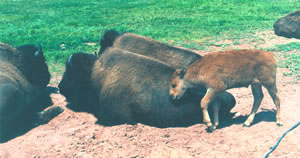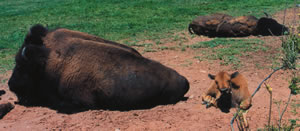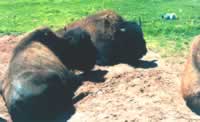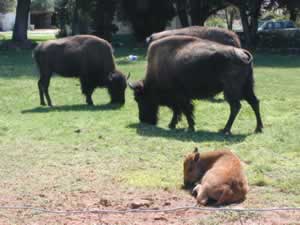PET HAPPENINGS - AUGUST 2001
Give me A Home Where The Buffalo Roam...
by Carol N. Wells
 When
people stop by the roadside to get a closer look at the Buffalo
in the front yard of Robin Groff’s 2-acre ‘ranch’,
they often ask, “Are they pets?”
When
people stop by the roadside to get a closer look at the Buffalo
in the front yard of Robin Groff’s 2-acre ‘ranch’,
they often ask, “Are they pets?”
“Being an aggressive animal at 1700 pounds that can run 35
m.p.h., no, they are not pets! What kind of pets do you have?”
is Robin’s answer. Still, Robin and Woody Marshall have managed
to name the four Buffalo, and one calf that makes up the small herd
they have acquired.
What was the motivation behind getting Buffalo in the first place?
Robin explains, “I applied for Buffalo hunt in the Henry Mountains
held by the UDWR (Utah Division of Wildlife Resources) of Hanksville
for 32 years in a row. I never drew a permit. I finally decided
I could buy Buffalo and just sit on the front porch and have my
own Buffalo hunt, without the UDWR.”
About a year ago, Robin and Woody saw an ad in Moab’s The Advertiser
that had Buffalo for sale in Fruita, Co. Robin says Buffalo average
about $1,000 per head. So, Robin and Woody decided to take the chance
and bought three young males. The three males all weighed around
650 to 750 pounds at the time, since they were not even half grown.
Unfortunately, one of the males died, but the other two, “Stumpy”
and “Ty” remain strong. At this age “Buffalo Ball”
was a popular sport that Woody played with them. Woody could kick
a basketball to “Stumpy,” the smallest one, who would
then hook the ball with his horns and throw it back about 30 feet
straight into Woody’s hands. Woody also says when they were
younger, he could call them from the barn and they would obediently
come in from the field. But all that changed after they reached
1500 pounds, and particularly after Robin and Woody recently purchased
2 cows whom they named Darling and Babe.
 One
of the cows was pregnant when they purchased her and had just given
birth the day before I arrived for the interview. The calf has been
named Custer after Custer’s Last Stand which took place 125
years ago, on June 2nd.
One
of the cows was pregnant when they purchased her and had just given
birth the day before I arrived for the interview. The calf has been
named Custer after Custer’s Last Stand which took place 125
years ago, on June 2nd.
Robin and Woody both know their stuff about Buffalo, which incidentally,
Robin reminded me that their true name is Bison, not Buffalo.
Just how did the name come to be Buffalo?
“Well,” Woody claims, “It’s just plain fun to
say,” and adds that, “You can say you’ve been Buffaloed,
but you can’t say you’ve been Bisoned.” How true.
As Robin pointed out, the name Buffalo actually comes from the wild
oxen, Water Buffalo and Cape Buffalo of Africa and Asia. The naming
of the Bison actually came through French and English Explorers
in the early 1600-1700’s when they gave their accounts of game
animals. Early French explorers called them Bison because they looked
like a European cousin.” Robin went on to say, “Bison
are quicker, more agile than horses, and weigh up to 2,000 pounds
and sometimes well over. One that I know of weighs 3,500 pounds.
They are the largest land mammal in North America and that includes
Moose, Grizzly and Polar bears. They are the only indigenous cattle
to the American continent and have been successfully crossbred with
their domestic cousins to produce ‘beefalo’.”
I asked Robin what they eat and what kind of
grooming they require, and in general, their natures.
“In the winter, we feed them hay twice a
day. They’re basically browsers. They eat the raspberry bushes,
roses, elm trees, and graze on the grass during the day and wallow
in the dirt. We also supplement their diets with grains. Unlike
horses, there’s no grooming required because they do their
own grooming, rubbing up against trees. They have a real thick hide
and even when it’s 110°, you can find them lying in the
sun. They reach full maturity after about three years and can live
up to 30-40 years, even though their average is about 20 years.
I have not seen anything that they’re afraid of. They’ll
charge when cornered and it doesn’t take much to make them
feel cornered. I’ve never experienced such an aggressive animal
that you could consider down right mean, and without a doubt are
dangerous.”
Between Robin and Woody, their plans for the future of raising Bison
was divergent. I asked if they had plans for raising them as meat
production, much as cattle have been; to which Robin replied, “Actually,
I think everyone in Moab should have a Bison of their own.”
But Woody has other ideas, one of which is riding a Bison in the
Rodeo parade. Woody says he was actually scheduled to ride one in
this year’s parade but hasn’t quite worked out all the
“bugs” in the training technique. One of the problems
as Woody put it, “You can get them to do anything they want.”
 However,
Custer, who is quite young and impressionable may be just the ticket,
that is if Custer’s mama doesn’t mind Woody training him
for the rodeo.
However,
Custer, who is quite young and impressionable may be just the ticket,
that is if Custer’s mama doesn’t mind Woody training him
for the rodeo.
Woody also has a great marketing idea. “They eat goat-heads
or sand burrs as people might call them, even the dried ones. I
think they’d make great sand burr exterminators for people’s
yards that are infested with them.” But mainly, Woody really
enjoys the sheer adrenaline rush that comes from near brushes with
death. Being gored and/or trampled while trying to tend to the enormous
beasts can be a daily encounter. “It’s thrilling and makes
you feel very alive,” adds Woody.
However, Robin does not share in the wondrous feeling of aliveness
that comes from dodging their charges, and has tangled with Stumpy
enough times that he is beginning to try Robin’s patience.
In Stumpy’s case, Robin has contemplated making good on his
word of hunting from the porch. Robin and Woody both are in amazement
at how many people stop each evening to see the Bison out near the
front fence. Even a tour bus has stopped once.
Asked why anyone would want to own a Bison in the first place, both
Woody and Robin agreed that, “they serve a historical and spiritual
significance. It is the return of the ‘Buffalo’.”
 This
is as good a reason as any, since it was the white man who first
began the slaughter of Bison by the millions in the late 1800’s.
The average number of Bison estimated to have roamed the great plains
from 1700’s-1800’s is 60 million. The extermination of
the Bison began in 1830 when the government advocated killing the
animals to subdue the “hostile” Indian tribes through
starvation. The Kansas and Pacific Railroad promoted the slaughter
of the Bison herds by mounting heads and shipping them to the East.
Trains would carry nothing but buffalo robes, millions at a time,
to the East. The tongue and hide became a status symbol. If you
could eat or wear Bison, you were considered a “somebody”.
Trains also sent loads of live Bison on tour. For ten dollars, you
could buy a trip on a luxury coach with a gun and ammunition and
shoot until you were out of bullets or your barrel became too hot;
all from the window of the train.
This
is as good a reason as any, since it was the white man who first
began the slaughter of Bison by the millions in the late 1800’s.
The average number of Bison estimated to have roamed the great plains
from 1700’s-1800’s is 60 million. The extermination of
the Bison began in 1830 when the government advocated killing the
animals to subdue the “hostile” Indian tribes through
starvation. The Kansas and Pacific Railroad promoted the slaughter
of the Bison herds by mounting heads and shipping them to the East.
Trains would carry nothing but buffalo robes, millions at a time,
to the East. The tongue and hide became a status symbol. If you
could eat or wear Bison, you were considered a “somebody”.
Trains also sent loads of live Bison on tour. For ten dollars, you
could buy a trip on a luxury coach with a gun and ammunition and
shoot until you were out of bullets or your barrel became too hot;
all from the window of the train.
The cowboys too, helped in the near extermination of animals since
cattle would run off to roam with the herds of their distant cousins.
Bison stampedes could also destroy cattle camps.
By 1885, only 500 Bison were left. Today, there are approximately
350,000 head of Bison throughout North America. Some of these animals
reside in public herds, in national parks, and the rest are owned
by private individuals who love them for their heritage, history,
and treat them with the respect they deserve.
Asked if they had any regrets about obtaining Bison, Robin and Woody
unanimously agreed, “Not-a-one!”
© 2001 Moab Happenings.
All rights reserved. Reproduction of information contained in this
site is expressly prohibited.